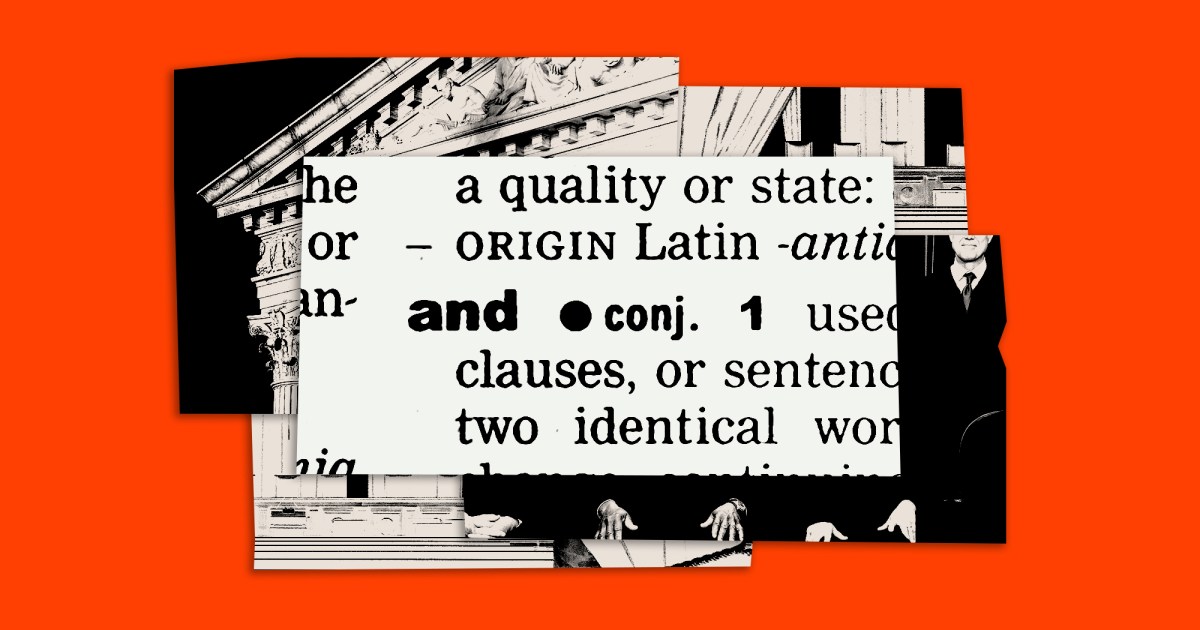This is what happens when you write a constitution with ambiguous language. People arguing about semantics rather than implementing solutions. Fuck, they even decided that the “Executive Office of the President of the United States” isn’t actually an “office” even though it literally has “Office” in its title.
This is a very misleading article. A lot of other comments are already touching on the nuance of the argument here, but I just want to break it down the way I understand it.
(Before that, though, I just want to point out that this is a 6-3 decision, but it’s not the usual 6-3, since Kagan and Gorsuch flipped sides. I think that’s telling enough that this isn’t simply a party-lines interpretation.)
It’s not that SCOTUS argued that “and” means “or”, it’s that when you have a statement “a person is eligible if not (a), (b), and ©”, there is ambiguity in the order of operations between “not” and “and”. The statement could either mean
(1) E = !(A and B and C)
or
(2) E = (!A) and (!B) and (!C)
Demorgan’s law says we can rewrite (1) and (2) as
(1) !E = A and B and C
(2) !E = A or B or C
The court went with interpretation (2), not because one is more “correct” than the other. It seems like (2) was chosen because of the two “statutory difficulties” listed in the syllabus of Pulsifer v. United States.
(1) Pulsifer’s reading would render Subparagraph A superfluous because a defendant who has a three-point offense under Subpara-graph B and a two-point offense under Subparagraph C will always have more than four criminal-history points under Subparagraph A. That reading leaves Subparagraph A with no work to do: removing it from the statute would make the exact same people eligible (and inel-igible) for relief. That kind of superfluity, in and of itself, refutes Pul-sifer’s reading. When a statutory construction “render[s] an entire subparagraph meaningless,” this Court has noted, the canon against surplusage applies with special force. National Assn. of Mfrs. v. Department of Defense, 583 U.S. 109, 128. That is particularly true when, as here, the subparagraph is so evidently designed to serve a concrete function. Pp. 15-20.
(2) Pulsifer’s reading would also create a second problem related to Paragraph (f)(1)'s gatekeeping function. The Guidelines presume that defendants with worse criminal records exhibiting recidivism, lengthy sentences, and violence deserve greater punishment. Under the Government’s reading, Paragraph (f)(1) sorts defendants accordingly. When the defendant has committed multiple non-minor of-fenses, he cannot get relief (Subparagraph A). And so too when he has committed even a single serious offense punished with a lengthy prison sentence (Subparagraph B) or one involving violence (Subpara-graph C). Pulsifer’s reading, by contrast, would allow safety-valve relief to defendants with more serious records while barring relief to defendants with less serious ones. A defendant with a three-point offense and a two-point violent offense would be denied relief. But a defendant with multiple three-point violent offenses could get relief simply because he happens not to have a two-point violent offense.
Contrary to Pulsifer’s view, that anomalous result cannot be ignored on the ground that a sentencing judge retains discretion to impose a lengthy sentence. If Congress thought it could always rely on sentencing discretion, it would not have created a criminal-history requirement in the first instance. Instead, it specified a requirement that allows such discretion to operate only if a defendant’s record does not reach a certain level of seriousness. Pulsifer’s construction of Paragraph (f)(1) makes a hash of that gatekeeping function. Pp. 20-23.
In summary, this is a ruling that could have gone either way, and the side the court chose isn’t totally ridiculous.
It is the side of giving fewer people just the eligibility for relief, which is pretty shitty. But if the court was stooping to an argument as bad as the headline made it out to be, IMO we’d have MUCH bigger problems.
Wouldn’t
(3) E = (!A) and B and C
also be a valid Interpretation?
This isn’t even remotely ambiguous. The DoJ’s interpretation is correct.
The question isn’t really about the meaning of “and”; it’s about the syntactic structure of the whole section.
A defendant is eligible if they do NOT have (A and B and C). In other words, having any of A, B or C will disqualify them.
The law could have been written in a more readable fashion, for example:
the defendant—
- (A) does not have more than 4 criminal history points…;
- (B) does not have a prior 3-point offense…; and
- © does not have a prior 2-point violent offense…
But the meaning is the same either way. Amazing that this got to the Supreme Court.
It’s also entirely plausible that this is exactly what was intended when the law was written.
Right! I feel like I’m going crazy because I don’t see how can you interpret it the other way!
lower courts were sharply divided on the vital question of whether “and” bundles the conditions—as in, you don’t have (A), don’t have (B), and don’t have ©—which would mean a defendant who lacked any one of these conditions would be eligible for relief. The alternative reading, advocated by the Justice Department, holds that “and” really means “or”—that a defendant who met even one of the conditions would not be eligible for relief
The reporter seems to be getting this totally wrong. It’s like he is saying the exact opposite of what I understand. From my point of view:
If a defendant would be elegible for relief if he lacked any one of the conditions, that is actually interpreting that AND means OR.
If a defendant would be eligible for relief if he lacked all of the conditions, that is interpreting that AND means AND.
Note the crucial difference between writing this as an enumerated list, and writing it as a continuous sentence.
In the former case (used here) the “xyz is not” distributes such that each point on the list can be read as a complete sentence, giving your (correct) interpretation.
What seems to confuse a lot of people is that if you write “xyz is not A, B, and C”, the “not” no longer distributes the same way, and (A, B, and C) is read as a single condition, giving the alternate (incorrect) interpretation.
This was my takeaway as a lawyer. So I’m glad I’m not alone.
Now thinking about it in terms of mathematical logic, the DoJ and Supreme Court‘s interpretations is wrong:
It’s actually a law of logic (https://en.wikipedia.org/wiki/De_Morgan's_laws) that says that:
not (A and B and C)
is equal to
(not A) or (not B) or (not C)
—
In this case:
The defendant is eligible for relief if he does not (A and B and C)
Which is the same as
The defendant is a eligible for relief if he does (not A) or (not B) or (not C)
—
Which is not what the DoJ is saying. The DoJ is saying that
not (A and B and C)
is equal to
(not A) and (not B) and (not C)
You’re missing the grammatical point of a itemised list though. Writing
abc is not
- condition 1,
- condition 2, and
- condition 3.
Reads as the “not” distributing so as to create the full sentence(es)
- abc is not condition 1,
- abc is not condition 2, and
- abc is not condition 3.
In other words, writing this as an itemised list makes it different from writing it as the sentence
abc is not condition 1, condition 2 and condition 3.
A conservative is incapable of entering any discussion or debate in good faith. Every word uttered by a conservative is deception or manipulation.
This illegitimate “supreme” court is infested with conservatives and should be disregarded and abandoned until it is corrected.
“It depends on what the meaning of ‘is’ is.”
While funny, the question they asked Clinton was weird as fuck.
“Is there a relationship with Ms. Lewenski?”
Replace some and with or in your code and see what happens!






